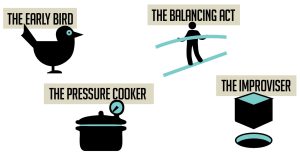4.1 Time Management
Stevy Scarbrough
Learning Objectives
Upon completion of this reading, you will be able to:
- Assess your current use of time.
- Describe the importance of organizing your space to your best advantage for studying.
- Identify your time management style.
- Describe how the Eisenhower Decision Matrix helps prioritize tasks.
- Describe effective time management techniques for students who work, students with family, and student athletes.
One of the main goals of a college education is learning how to learn. In this section, we zoom in on learning how to skillfully manage your time. To be successful in college, it’s imperative to be able to effectively manage your time and to manage all aspects of your life including school, work, and social opportunities. Time management isn’t actually difficult, but you do need to learn how to do it well. The best way to improve your time management is to take an honest look at how you are currently spending your time.
Assess Your Use Of Time
The best way to know how you spend your time is to record what you do all day in a time log, every day for a week, and then add that up. First, you want to take your best guess at how you are currently spending your time so you can compare that with how you are actually spending your time. This helps you identify the areas you need to work on.
After you’ve evaluated how you have done things in the past, you’ll want to think about how you might create a schedule for managing your time well going forward. The best schedules have some flexibility built into them, as unexpected situations and circumstances will likely arise during your time as a student.
For every hour in the classroom, college students should spend, on average, about two to three hours on that class reading, studying, writing papers, and so on outside of class time. Look at the following scenarios to get an idea of how many hours you should be spending on your classes outside of class time.
12 credit hours = 12 hours a week in class + 24-36 hours outside of class
If you’re a full-time student with twelve hours a week in class plus your study time, that 36-42 hours is about the same as a typical full-time job, which is why you are considered to be a full-time student. If you work part-time, full-time, or have a family, time management skills are even more essential. To succeed in college, everyone has to develop effective strategies for dealing with time.
Do you have two to three hours of study time for every hour in class? Many students begin college not knowing this much time is needed. Remember this is just an average amount of study time—you may need more or less for your own courses. To be safe, and to help ensure your success, add another five to ten hours a week for studying.
To reserve this study time, you may need to adjust how much time you spend on other activities.
Knowing Yourself
While you can find all sorts of estimates online as to how long a certain task may take, it is important to know these are only averages. People read at different speeds, people write at different speeds, and those numbers even change for each individual depending on the environment.
If you are trying to read in surroundings that have distractions (e.g., conversations, phone calls, etc.), reading 10 pages can take you a lot longer than if you are reading in a quiet area. By the same token, you may be reading in a quiet environment (e.g., in bed after everyone in the house has gone to sleep), but if you are tired, your attention and retention may not be what it would be if you were refreshed.
In essence, the only way you are going to be able to manage your time accurately is to know yourself and to know how long it takes you to do each task. But where to begin?
Below, you will find a table of common college academic activities. This list has been compiled from a large number of different sources, including colleges, publishers, and professional educators, to help students estimate their own time on tasks. The purpose of this table is to both give you a place to begin in your estimates and to illustrate how different factors can impact the actual time spent.
You will notice that beside each task there is a column for the unit, followed by the average time on task, and a column for notes. The unit is whatever is being measured (e.g., pages read, pages written, etc.), and the time on task is an average time it takes students to do these tasks. It is important to pay attention to the notes column, because there you will find factors that influence the time on task. These factors can dramatically change the amount of time the activity takes.
| Activity | Unit | Time on task | Notes |
| General academic reading (textbook, professional journals) | 1 page | 5–7 minutes | Be aware that your personal reading speed may differ and may change over time. |
| Technical reading (math, charts and data) | 1 page | 10–15 minutes | Be aware that your personal reading speed may differ and may change over time. |
| Simple Quiz or homework question: short answer—oriented toward recall or identification type answers | Per question | 1–2 minutes | Complexity of question will greatly influence the time required. |
| Complex Quiz or homework question: short answer—oriented toward application, evaluation, or synthesis of knowledge | Per question | 2–3 minutes | Complexity of question will greatly influence the time required. |
| Math problem sets, complex | Per question | 15 minutes | For example, algebra, complex equations, financial calculations |
| Writing: short, no research | Per page | 60 minutes | Short essays, single-topic writing assignments, summaries, freewriting assignments, journaling—includes drafting, writing, proofing, and finalizing |
| Writing: research paper | Per page | 105 minutes | Includes research time, drafting, editing, proofing, and finalizing (built into per-page calculation) |
| Study for quiz | Per chapter | 60 minutes | 45–90 minutes per chapter, depending upon complexity of material |
| Study for exam | Per exam | 90 minutes | 1–2 hours, depending upon complexity of material |
Again, these are averages, and it does not mean anything if your times are a little slower or a little faster. There is no “right amount of time,” only the time that it takes you to do something so you can accurately plan and manage your time.
There is also another element to look for in the table. These are differentiations in the similar activities that will also affect the time you spend. A good example of this can be found in the first four rows. Each of these activities involves reading, but you can see that depending on the material being read and its complexity, the time spent can vary greatly. Not only do these differences in time account for the different types of materials you might read, but also they also take into consideration the time needed to think about what you are reading to truly understand and comprehend what it is saying.
The Importance of Where You Do Your Work
A large part of ensuring that you can complete tasks on time comes to setting up conditions that will allow you to do the work well. Much of this has to do with the environment where you will do your work. This not only includes physical space such as a work area, but other conditions like being free from distractions and your physical well-being and mental attitude.
The Right Space
Simple things, like where you are set up to do your work, can not only aid in your efficiency but also affect how well you can work or even if you can get the work completed at all. One example of this might be typing on a laptop. While it might seem more comfortable to lie back on a couch and type a long paper, sitting up at a desk or table actually increases your typing speed and reduces the number of mistakes. Even the kind of mouse you use can impact how you work, and using one you are comfortable with can make a big difference.
There are a host of other factors that can come into play as well. Do you have enough space? Is the space cluttered, or do you have the room to keep reference materials and other things you might need within arm’s reach? Are there other ways you could work that might be even more efficient? For example, buying an inexpensive second monitor—even secondhand—might be the key to decreasing the amount of time you spend when you can have more than one document displayed at a time. The key is to find what works for you and to treat your work space as another important resource needed to get the task finished.

Distraction Free
Few things are more frustrating than trying to do work while distractions are going on around you. If other people are continually interrupting you or there are things that keep pulling your attention from the task at hand, everything takes longer and you are more prone to mistakes.
Many people say they work better with distractions—they prefer to leave the television or the radio on—but the truth is that an environment with too many interruptions is rarely helpful when focus is required. Before deciding that the television or talkative roommates do not bother you when you work, take an honest accounting of the work you produce with interruptions compared to work you do without.
If you find that your work is better without distractions, it is a good idea to create an environment that reduces interruptions. This may mean you have to go to a private room, use headphones, or go somewhere like a library to work. Regardless, the importance of a distraction-free environment cannot be emphasized enough.

Most people are subject to their own rhythms, cycles, and preferences throughout their day. Some are alert and energetic in the mornings, while others are considered “night owls” and prefer to work after everyone else has gone to sleep. It can be important to be aware of your own cycles and to use them to your advantage. Rarely does anyone do their best work when they are exhausted, either physically or mentally. Just as it can be difficult to work when you are physically ill, it can also be a hindrance to try to learn or do mental work when you are tired or emotionally upset.
Your working environment definitely includes your own state of mind and physical well-being. Both have a significant influence on your learning and production ability. Because of this, it is not only important to be aware of your own condition and work preferences, but to actually try to create conditions that help you in these areas. One approach is to set aside a specific time to do certain kinds of work. You might find that you concentrate better after you have eaten a meal. If that is the case, make it a habit of doing homework every night after dinner. Or you might enjoy reading more after you are ready for bed, so you do your reading assignments just before you go to sleep at night. Some people find that they are more creative during a certain time of the day or that they are more comfortable writing with subtle lighting. It is worth taking the time to find the conditions that work best for you so that you can take advantage of them.
Identify Your Time Management Style
People’s attitudes toward time vary widely. One person seems to be always rushing around but actually gets less done than another person who seems unconcerned about time and calmly goes about the day. Since there are so many different “time personalities,” it’s important to realize how you approach time.

The Early Bird
Traits: You like to make checklists and feel great satisfaction when you can cross something off of your to-do list. When it comes to assignments, you want to get started as soon as possible (and maybe start brainstorming before that), because it lets you stay in control.
Strengths: You know what you want and are driven to figure out how to achieve it. Motivation is never really a problem for you.
Challenges: Sometimes you can get more caught up in getting things done as quickly as possible and don’t give yourself enough time to really mull over issues in all of their complexity.
Tips for Success: You’re extremely organized and on top of your schoolwork, so make sure you take the time to really enjoy learning in your classes. Remember, school isn’t all deadlines and checkboxes—you also have the opportunity to think about big-picture intellectual problems that don’t necessarily have clear answers.
The Balancing Act
Traits: You really know what you’re capable of and are ready to do what it takes to get the most out of your classes. Maybe you’re naturally gifted in this way or maybe it’s a skill that you have developed over time; in any case, you should have the basic organizational skills to succeed in any class, as long as you keep your balance.
Strengths: Your strength really lies in your ability to be well rounded. You may not always complete assignments perfectly every time, but you are remarkably consistent and usually manage to do very well in classes.
Challenges: Because you’re so consistent, sometimes you can get in a bit of a rut and begin to coast in class, rather than really challenging yourself.
Tips for Success: Instead of simply doing what works, use each class as an opportunity for growth by engaging thoughtfully with the material and constantly pushing the boundaries of your own expectations for yourself.
The Pressure Cooker
Traits: You always get things done and almost always at the last minute. Hey, it takes time to really come up with good ideas!
Strengths: You work well under pressure, and when you do finally sit down to accomplish a task, you can sit and work for hours. In these times, you can be extremely focused and shut out the rest of the world in order to complete what’s needed.
Challenges: You sometimes use your ability to work under pressure as an excuse to procrastinate. Sure, you can really focus when the deadline is tomorrow but is it really the best work you could produce if you had a couple of days of cushion?
Tips for Success: Give yourself small, achievable deadlines, and stick to them. Make sure they’re goals that you really could (and would) achieve in a day. Then don’t allow yourself to make excuses. You’ll find that it’s actually a lot more enjoyable to not be stressed out when completing schoolwork. Who would have known?
The Improviser
Traits: You frequently wait until the last minute to do assignments, but it’s because you’ve been able to get away with this habit in many classes. Sometimes you miss an assignment or two, or have to pretend to have done reading that you haven’t, but everyone does that sometimes, right?
Strengths: You think quickly on your feet, and while this is a true strength, it also can be a crutch that prevents you from being really successful in a class.
Challenges: As the saying goes, old habits die hard. If you find that you lack a foundation of discipline and personal accountability, it can be difficult to change, especially when the course material becomes challenging or you find yourself struggling to keep up with the pace of the class.
Tips for Success: The good news is you can turn this around! Make a plan to organize your time and materials in a reasonable way, and really stick with it. Also, don’t be afraid to ask your instructor for help, but be sure to do it before, rather than after, you fall behind.
People also differ in how they respond to schedule changes. Some go with the flow and accept changes easily, while others function well only when following a planned schedule and may become upset if that schedule changes. If you do not react well to an unexpected disruption in your schedule, plan extra time for catching up if something throws you off.
Identifying Your Priorities
We often use the word “priorities” to refer to how important something is to us. We might think, this is a really important goal, and that is less important. In reality, priorities don’t work quite that way. It doesn’t make a lot of sense to try to rank goals or tasks as always more or less important. The question of priority is really a question of what is more important at a specific time. It is important to do well in your classes, but it’s also important to earn money to support yourself and have a social life. You shouldn’t have to choose between these, except at any given time. Priorities always involve time: what is most important to do right now. Time management is a way to juggle priorities so you can meet all your goals.
When you manage your time well, you don’t have to ignore some goals completely in order to meet other goals. In other words, you don’t have to give up your life when you register for college, but you may need to work on managing your life and time more effectively.
Time management works only when you’re committed to your goals. Attitude and motivation are very important. If you haven’t yet developed an attitude for success, all the time management skills in the world won’t keep you focused and motivated to succeed.
The Eisenhower Method
One way to help you identify your priorities is with the “Eisenhower Box,” a tool to help evaluate urgency and importance. Items may be placed at more precise points within each quadrant.
The “Eisenhower Method” stems from a quote attributed to Dwight D. Eisenhower: “I have two kinds of problems, the urgent and the important. The urgent are not important, and the important are never urgent.”
Using the Eisenhower Decision Principle, tasks are evaluated using the criteria High Urgency/Low Urgency and High Importance/Low Importance, and then placed in according quadrants in an Eisenhower Matrix (also known as an “Eisenhower Box” or “Eisenhower Decision Matrix”). It is important to understand the difference between urgency and importance. An urgent item needs to be dealt with immediately. An item that is important needs to be dealt with but may or may not need to be dealt with immediately.
| High Urgency | Low Urgency | |
|---|---|---|
| High Importance | High Urgency/High Importance items must be taken care of immediately. Examples include:
|
Low Urgency/High Importance items need to be accomplished but have an end date or due date that isn’t urgent or pressing. Examples include:
|
| Low Importance | High Urgency/Low Importance are items that can often feel urgent but they really aren’t. Although they may feel like they need to be attended to immediately, they are not very important and can actually wait. Examples include:
|
Low Urgency/Low Importance items are your time wasters, things that are not important and not urgent. Examples include things like:
|
As you can see, the High Urgency/High Importance category (#1) needs to be attended to first and should top your list of priorities, followed by the High Importance/Low Urgency category (#2). You can imagine that the Category #1 is a stressful place, with emergencies and crises, and one you would like to avoid. Life will bring you plenty of Category #1 items so try your best to keep things out of that category. Work productively in Category #2 so items don’t unnecessarily end up being urgent. For example, a paper or a test shouldn’t be urgent, as they aren’t a last-minute crisis. The more you focus on Category #2, the more you accomplish with less stress.
Time Management Tips for Students Who Work

If you’re both working and taking classes, you seldom have large blocks of free time. Avoid temptations to stay up very late studying, for losing sleep can lead to a downward spiral in performance at both work and school. Instead, try to follow these guidelines:
- If possible, adjust your work or sleep hours so that you don’t spend your most productive times at work. If your job offers flex time, arrange your schedule to be free to study at times when you perform best.
- Try to arrange your class and work schedules to minimize commuting time. If you are a part-time student taking two classes, taking classes back-to-back two or three days a week uses less time than spreading them out over four or five days. Working four ten-hour days rather than five eight-hour days reduces time lost to travel, getting ready for work, and so on.
- If you can’t arrange an effective schedule for classes and work, consider online courses that allow you to do most of the work on your own time.
- Use your daily and weekly planner conscientiously. Anytime you have thirty minutes or more free, schedule a study activity.
- Consider your “body clock” when you schedule activities. Plan easier tasks for those times when you’re often fatigued and reserve alert times for more demanding tasks.
- Look for any “hidden” time potentials. Maybe you prefer the thirty-minute drive to work over a forty-five-minute train ride. But if you can read on the train, that’s a gain of ninety minutes every day at the cost of thirty minutes longer travel time. An hour a day can make a huge difference in your studies.
- Can you do quick study tasks during slow times at work? Take your class notes with you and use even five minutes of free time wisely.
- Remember your long-term goals. You need to work, but you also want to finish your college program. If you have the opportunity to volunteer for some overtime, consider whether it’s really worth it. Sure, the extra money would help, but could the extra time put you at risk for not doing well in your classes?
- Be as organized on the job as you are academically. Use your planner and to-do list for work matters, too. The better organized you are at work, the less stress you’ll feel—and the more successful you’ll be as a student also.
Time Management Tips for Students with Family

Living with family members often introduces additional time stresses. You may have family obligations that require careful time management. Use all the strategies described earlier, including family time in your daily plans the same as you would hours spent at work. Don’t assume that you’ll be “free” every hour you’re home, because family events or a family member’s need for your assistance may occur at unexpected times. Schedule your important academic work well ahead and in blocks of time you control. See also the earlier suggestions for controlling your space: you may need to use the library or another space to ensure you are not interrupted or distracted during important study times.
Students with their own families are likely to feel time pressures. After all, you can’t just tell your partner or kids that you’ll see them in a couple years when you’re not so busy with work and college! In addition to all the planning and study strategies discussed so far, you also need to manage your family relationships and time spent with family. While there’s no magical solution for making more hours in the day, even with this added time pressure there are ways to balance your life well:
Talk everything over with your family. If you’re going back to school, your family members may not have realized changes will occur. Don’t let them be shocked by sudden household changes. Keep communication lines open so that your partner and children feel they’re together with you in this new adventure. Eventually, you will need their support.
Work to enjoy your time together, whatever you’re doing. You may not have as much time together as previously, but cherish the time you do have—even if it’s washing dishes together or cleaning house. If you’ve been studying for two hours and need a break, spend the next ten minutes with family instead of checking e-mail or watching television. Ultimately, the important thing is being together, not going out to movies or dinners or the special things you used to do when you had more time. Look forward to being with family and appreciate every moment you are together, and they will share your attitude.
Time Management Tips for Student Athletes

Student athletes often face unique time pressures because of the amount of time required for training, practice, and competition. During some parts of the year, athletics may involve as many hours as a full-time job. The athletic schedule can be grueling, involving weekend travel and intensive blocks of time. You can be exhausted after workouts or competitions, affecting how well you can concentrate on studies thereafter. Students on athletic scholarships often feel their sport is their most important reason for being in college, and this priority can affect their attitudes toward studying. For all of these reasons, student athletes face special time management challenges. Here are some tips for succeeding in both your sport and academics:
- Realize that even if your sport is more important to you, you risk everything if you don’t also succeed in your academics. Failing one class in your first year won’t get you kicked out, but you’ll have to make up that class—and you’ll end up spending more time on the subject than if you’d studied more to pass it the first time.
- It’s critical to plan ahead. If you have a big test or a paper due the Monday after a big weekend game, start early. Use your weekly planner to plan well in advance, making it a goal, for example, to have the paper done by Friday—instead of thinking you can magically get it done Sunday night after victory celebrations. Working ahead will also free your mind to focus better on your sport.
- Accept that you have two priorities—your sport and your classes—and that both come before your social life. That’s just how it is—what you have accepted in your choice to be a college athlete. If it helps, think of your classes as your job; you have to “go to study” the same as others “go to work.”
- Use your planner to take advantage of any downtime you have during the day between classes and at lunch. Other students may seem to have the luxury of studying during much of the afternoon when you’re at practice, and maybe they can get away with hanging out between classes, but you don’t have that time available, at least not during the season. You need to use all the time you can find to keep up with your studying.
- Stay on top of your courses. If you allow yourself to start slipping behind, maybe telling yourself you’ll have more time later on to catch up, just the opposite will happen. Once you get behind, you’ll lose momentum and find it more difficult to understand what’s going on the class. Eventually the stress will affect your athletic performance also.
- Get help when you need it. Many athletic departments offer tutoring services or referrals for extra help. But don’t wait until you’re at risk for failing a class before seeking help. A tutor won’t take your test or write your paper for you—they can only help you focus in to use your time productively in your studies. You still have to want to succeed.
Attributions
College Success. Authored by: Linda Bruce. Provided by: Lumen Learning. License: CC BY 4.0
Manage Your Time. Authored by: Heather Syrett. Provided by: Austin Community College. License: CC BY-NC-SA-4.0
Online Learning. Authored by: Beverly Araujo. Provided by: Lumen Learning. Located at: https://courses.lumenlearning.com/wm-collegesuccess-2/chapter/online-learning/. License: CC BY 4.0
Technology for College Learning. Authored by: Beverly Araujo. Provided by: Lumen Learning. Located at: https://courses.lumenlearning.com/wm-collegesuccess-2/chapter/text-technology-for-college-learning/. License: CC BY 4.0
Curriculum Design and Educational Technology. Authored by: Thomas Tobiason. Provided by: OpenStax; Modified by Lumen Learning. Located at: https://www.oercommons.org/courses/curriculum-design-and-educational-technology/view. License: CC BY 4.0

